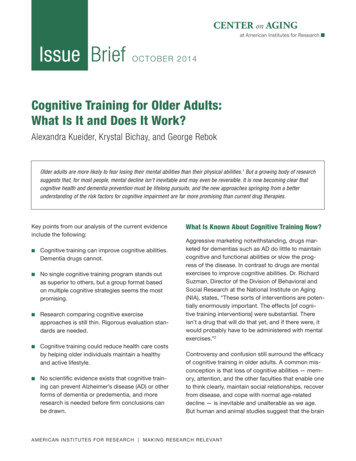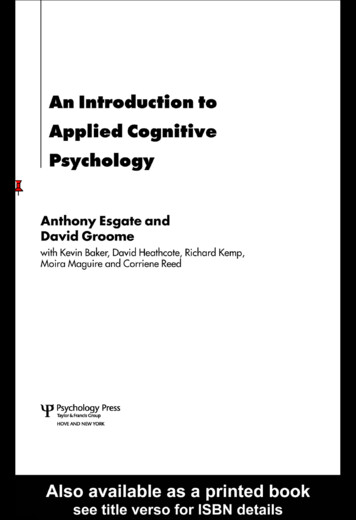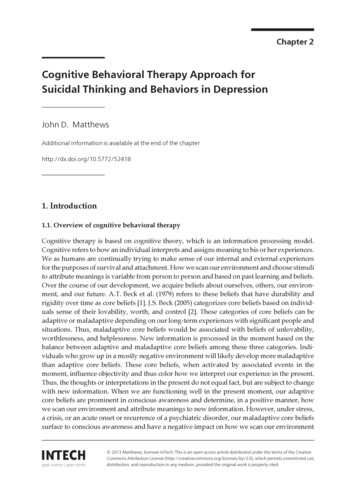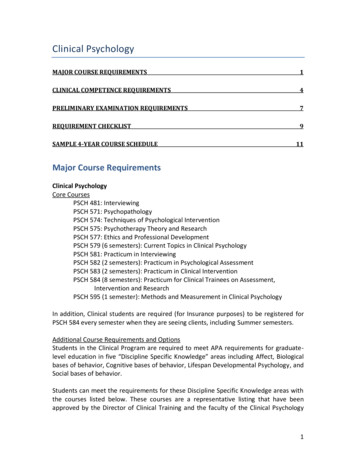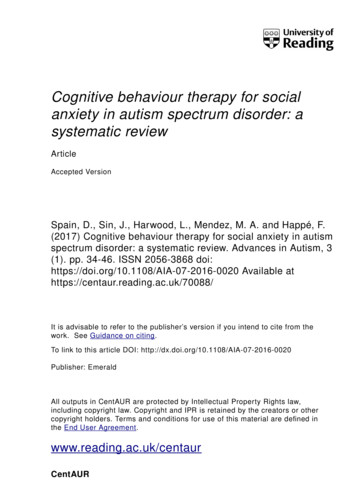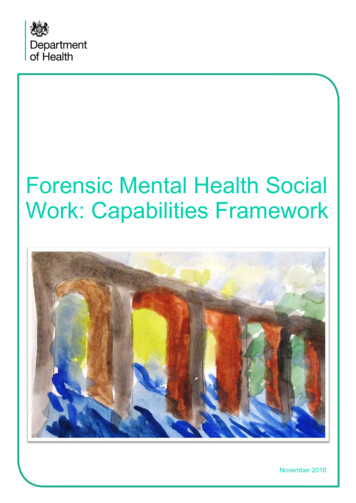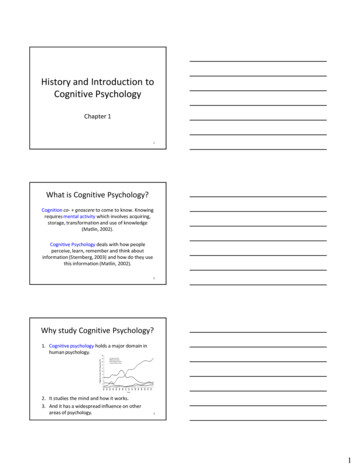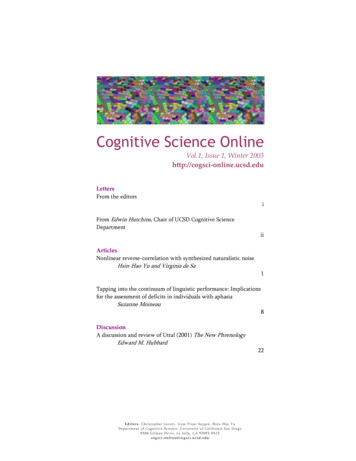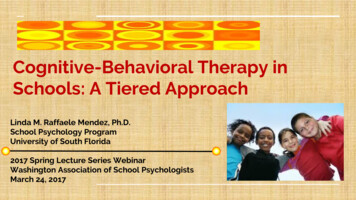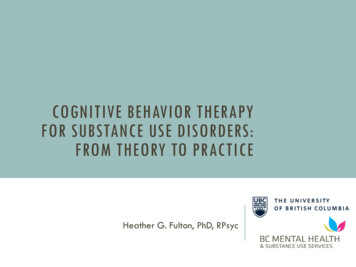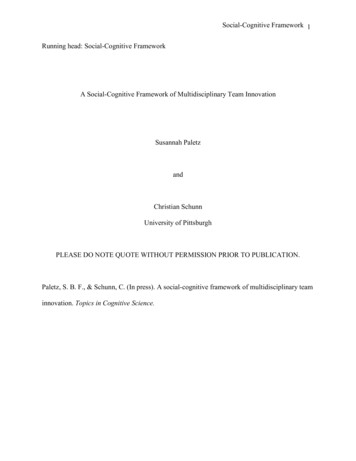
Transcription
Social-Cognitive Framework 1Running head: Social-Cognitive FrameworkA Social-Cognitive Framework of Multidisciplinary Team InnovationSusannah PaletzandChristian SchunnUniversity of PittsburghPLEASE DO NOTE QUOTE WITHOUT PERMISSION PRIOR TO PUBLICATION.Paletz, S. B. F., & Schunn, C. (In press). A social-cognitive framework of multidisciplinary teaminnovation. Topics in Cognitive Science.
Social-Cognitive Framework 2AbstractThe psychology of science typically lacks integration between cognitive and social variables. Wepresent a new framework of team innovation in multidisciplinary science and engineering groupsthat ties factors from both literatures together. We focus on the effects of a particularlychallenging social factor, knowledge diversity, which has a history of mixed effects on creativity,most likely because those effects are mediated and moderated by cognitive and additional socialvariables. In addition, we highlight the distinction between team innovative processes that areprimarily divergent versus convergent; we propose that the social and cognitive implications aredifferent for each, providing a possible explanation for knowledge diversity’s mixed results onteam outcomes. Social variables mapped out include formal roles, communication norms,sufficient participation and information sharing, and task conflict; cognitive variables includeanalogy, information search, and evaluation. This framework provides a roadmap for researchthat aims to harness the power of multidisciplinary teams.
Social-Cognitive Framework 3A Social-Cognitive Framework of Multidisciplinary Team InnovationThe history, philosophy, and sociology of science and technology are long-standing andactive fields. The psychology of science and technology is much more nascent, having onlygraduated in the last year to having a society, journal, and conference (Feist, 2008). It alsoremains far from a coherent discipline: In particular, there has traditionally been a dividebetween social psychology and cognitive science when it comes to studying creativity. Instead ofworking towards an integrated understanding of scientific discovery and technologicalinnovation, social and cognitive psychologists have largely studied creativity and innovation inisolation of one another. This divide seems particularly counterproductive because cognitivepsychologists of science and technology have begun to move from studies of individualsworking alone to studies of dyads (e.g., Okada & Simon, 1997) or teams (Christensen & Schunn,2007; Dunbar, 1997), and social psychologists studying creativity have begun to borrowconstructs from cognitive psychology such as the accessibility of knowledge structures (Nijstad& Stroebe, 2006). Additionally, the choice of cross-disciplinary constructs lacks integration: Theconstructs used by cognitive psychologists of science and technology are usually not those usedby social psychologists in borrowing from cognitive science and vice-versa. For example,analogy and fixation are the most salient constructs from the cognitive science of creativity, butthose concepts are not used by social psychologists positing connections from social variables tocognition.Fortunately, there is movement toward bringing together insights from cognitive andsocial psychology, particularly in group cognition (e.g., Smith, 2008). This paper integratestheory from social psychology and cognitive science, focusing on the case of innovation in
Social-Cognitive Framework 4multidisciplinary science and engineering teams, which are a theoretically rich case from bothcognitive and social perspectives.Science and engineering teams are increasingly multidisciplinary. Funding agencies haverecognized that solving complex problems often requires teams from multiple disciplines, anduniversities are continuing to develop cross-disciplinary programs (Derry & Schunn, 2005). Onthe social side, knowledge diversity has been implicated as a positive factor in team innovation,but attempts to understand its effects have failed to find consistent results (Mannix & Neale,2005; van Knippenberg, De Dreu, & Homan, 2004). On the cognitive side, knowledge diversityis thought to be critical to complex performance, but is dependent upon communication methods(Okada & Simon, 1997). For the purpose of this framework, although we draw from a broadarray of literature on team diversity, we use the term ‘knowledge diversity’ to mean diversity indomains of knowledge expertise, such as in multidisciplinary science and engineering teams,rather than expert-novice or raw ability differences. Much of the diversity literature examineshomogeneous versus heterogeneous teams, although it is clear that there can be degrees ofheterogeneity (Paletz, Peng, Erez, & Maslach, 2004). Taking from Harrison and Klein’s (2007)typology of diversity, we are focusing on diversity as variety: in this case, variety of domains ofexpertise. This distinction is important, as groups diverse on levels of expertise within the samedomain will have a whole set of potentially different effects.Before continuing, it is also important to define creativity and innovation. Although theliterature we review often focuses on one or the other, our broad framework focuses oninnovation. Creativity is generally defined as a person, process, product, or environment thatformulates, results in, displays, or encourages both usefulness (appropriateness, correctness, orvalue) and originality/novelty (e.g., Amabile, 1983, 1996; Mayer, 1999). Innovation additionally
Social-Cognitive Framework 5includes the elements of relative rather than absolute novelty, intentional benefit to individual,group, organization, or wider society, and the application/implementation of the creative idea(West & Farr, 1990). Given that creativity has been used to describe products, which arenecessarily application of ideas, and processes, which imply personal/relative novelty of ideas, itis not a surprise that the concepts of creativity and innovation overlap somewhat. However, wetake Anderson and colleagues’ (Anderson, De Dreu, & Nijstad, 2004) lead to stress thatinnovation includes implementation, a standpoint that has implications for which variables willbe important.The goal of this paper is to create an initial framework of multidisciplinary teaminnovation that begins to integrate theory from both cognitive science and social psychology.This paper aims to open up the ‘black box’ between team structures (specifically,multidisciplinarity) and innovative team outcomes, detailing some of the potentially importantteam and cognitive processes that lie between the two. We propose that the previouslyinconsistent results for multidisciplinarity can be explained by distinguishing betweenconvergent and divergent processes, which we propose have different social and cognitiveeffects. Furthermore, we highlight formal roles as a possible team structure moderator on theeffects of multidisciplinarity. This framework is a first step: As research in this area progresses,we anticipate further specific models arising from this framework, as well as more completeaccounts that include more concepts.An Overview of TeamsGroups are often the unit within which modern science and engineering innovationoccurs (Levine & Moreland, 2004). Interdisciplinary groups in particular are becoming the normwithin certain areas of science and engineering (e.g., oceanography, space research, physics,
Social-Cognitive Framework 6Klein, 2005). Time Magazine’s top ten scientific discoveries of 2007 (Mahr, 2007) and theNational Science Foundation’s highlighted 2006 scientific discoveries (National ScienceFoundation, 2007) were all listed as originating from a team or collection of scientists orresearchers. The discovery of the double helix (Watson, 1968), the atomic bomb’s Manhattanproject, and the Apollo moon program are additional examples of how dramatic modernachievements and discoveries depend on multidisciplinary teams of scientists and engineers.Less dramatic but still vital innovation also originates from everyday software developmentgroups, labs within pharmaceutical companies, and collaborations of scientists acrossuniversities.Teams have been investigated within cognitive science. Hutchins’ (1995) groundbreakingarticle conceptualized a cockpit, with both the technological system and the humans involved, asa coordinated team of information processors: Memory was stored in the minds of the two pilotsas well as the speed card booklet and other representational devices. However, Hutchins’detailed description focused on information processing, retrieval, and memory between the pilotsand the airplane’s systems, rather than social processes. Other cognitive scientists of science andtechnology have discussed knowledge diversity in groups in terms of a broader base foranalogical thinking (Dunbar, 1995) or gaps in disciplinary language and goals that must bebridged using shared mental models (Epstein, 2005). Similarly, Okada and Simon (1997) discussthe collaborative process that must be used for initial knowledge diversity to lead to successfulscientific discoveries, but the process concepts they discuss are cognitive rather than social.Nersessian and colleagues, using ethnographic and cognitive-historical analyses to examinemultidisciplinary biomedical engineering teams, incorporate an understanding of context to
Social-Cognitive Framework 7describe in detail how reasoning can occur across artifacts and researchers (e.g., Nersessian,2006; Nersessian & Chandrasekharan, In press).The study of teams from a social and organizational psychological perspective has a longhistory and rich literature (see Ilgen, Hollenbeck, Johnson, & Jundt, 2005; Kozlowski & Ilgen,2006; Levine & Moreland, 1998, for reviews). Team creativity researchers have tended to focuson brainstorming (Thompson & Choi, 2006), which is a subset of what scientists and engineersdo in the service of innovation: They also problem solve, criticize, debate, test, and get off-topic.Most conceptual models of teamwork show some combination of four concepts: the broaderenvironmental and organizational context, the team task demands, team processes, and teamoutputs, generally in the input-process-output type of model (e.g., Kozlowski & Ilgen, 2006;McGrath, 1984; West, 2002). Certain aspects of group structure such as task design andorganizational context may influence group processes, which in turn influence groupeffectiveness (e.g., Cohen & Bailey, 1997). Saunders and Ahuja (2006) have improved upon thismodel by suggesting that, in ongoing distributed teams, structure influences and is influenced byboth processes and outcomes. Relevant team structures to science and engineering groupsinclude whether the team is distributed or co-located, what type of leadership roles are held byteam members, the level of formalism of those roles (are they implied or explicit?), and howmany people are on the team. The same overall task (e.g., robotic geology on Mars, Squyres,2005) can involve organizational constraints, such as funding fluctuations, and task structures,such as daily versus weekly planning. Therefore, we add organizational and task structures toSaunders and Ahuja’s (2006) model (see Figure 1). Task structures refer to how the work itself isorganized, whereas team structures refer to how the people are organized and composed and therelationships between them (McGrath, Arrow, Gruenfeld, Hollingshead, & O’Connor, 1993).
Social-Cognitive Framework 8Within multidisciplinary science and engineering teams, task structures could include whetherthe task requires decision-making, planning, and/or brainstorming, and whether it has a specificdeliverable at the end of each meeting or the end of each week.Insert Figure 1 about HereOne weakness of models of team productivity is that they often do not make connectionsbetween team and individual cognitive processes (exceptions being De Dreu, Nijstad, & vanKnippenberg, 2008; Nijstad & Stroebe, 2006). Not all social variables must play themselves outthrough individual cognitive changes, nor do all individual cognitive changes occur together withteam changes. However, many social variables can produce differences in individual cognition toaffect overall team productivity indirectly, and situational variables that may influence cognitiveprocesses may also change team process variables and influence overall team productivity in thisway. Because real science and engineering typically happens within team contexts with bothsocial and cognitive variables at play, thorough descriptions must be developed that furtherintegrate the social and cognitive processes.With this integration goal in mind, we present a new framework of team innovation inmultidisciplinary science and engineering groups that ties together social and cognitive variables.We focus on the effects of a particularly challenging social factor, knowledge diversity (asmultidisciplinarity), which has a history of mixed results, most likely because it is mediated andmoderated by cognitive and additional social variables. The framework we propose follows thoseteam structures, team processes, and cognitive processes that are most likely to be related toknowledge diversity. We also assume that this framework is most relevant for long-term groups,the typical kind of group in action in science and engineering, although perhaps the kind ofgroup that is studied the least often by social psychologists. Other high-level factors, such as
Social-Cognitive Framework 9those listed in Figure 1 are, of course, potentially important to scientific and engineering teaminnovation: Clearly, culture, organizational structures, differences in task structure, hierarchies,and other team processes may impact creativity in this context. Long term teams have processesof formation, maintenance, and dissolution (Levine & Moreland, 2004), and there may also befeedback loops, such that outcomes affect structure and processes and groups. This frameworkfocuses on interactions within teams, but we recognize that teams exist within social contextssuch as organizations, nations, and cultures, with their associated pressures, expectations, andnorms. Consideration of these factors lie beyond the scope of this article. However, there isheuristic value in beginning with the simple case in this integration of cognitive and socialvariables, and so we focus on a specific set of team structure, team process, and cognitiveprocess variables that are especially likely to cohere together.A Social/Cognitive Framework of Multidisciplinary Science and Engineering Team InnovationMultidisciplinary teams both hold the promise of broad solutions and a great deal ofdifficulty (Derry, Schunn, & Gernsbacher, 2005). Diversity in teams, particularly knowledgediversity, has historically resulted in mixed effects on teamwork: It is often positively associatedwith divergent thinking but can also hinder convergent thinking via increasing unproductiveconflict and making it difficult to achieve a shared vision (Kurtzberg & Amabile, 2000-2001;Gebert, Boerner, & Kearney, 2006; see Mannix & Neale, 2005, van Knippenberg & Schippers,2007 for reviews). Attempts to unpack and delineate the effects of diversity have served up weakor inconsistent results (Mannix & Neale, 2005; van Knippenberg, De Dreu, & Homan, 2004); asa result, some authors have suggested that new models showing moderation and/or mediation arenecessary (van Knippenberg, De Dreu, & Homan, 2004; van Knippenberg & Schippers, 2007).
Social-Cognitive Framework 10In addition to unpacking cognitive mediators of team innovation process, we propose twoadditional factors that may explain the difficulty in pinning down knowledge diversity effects.First, formal roles, and more specifically, the formalization of roles, are a key moderating factor.Formal roles are a type of team structure encompassing the behavioral norms and scriptssurrounding individuals’ roles. Furthermore, when a role has been formalized, it carries theweight of team structure and organizational expectations behind it. An informal note-taker atmeetings may choose to forgo the role at any time, but a formal note-taker is explicitly expectedto keep track of what agenda items are addressed and disseminate his or her notes to the rest ofthe group. For the purposes of this framework, we emphasize the type of formal role that reifiesexpertise in addition to delineating specific tasks and responsibilities. For example, thedistinction between the pilot flying (PF) and the pilot not flying (PNF) allows for a division oflabor within the cockpit (Hutchins, 1995). Each pilot is responsible for a different set of tasks,but even more importantly, is considered an expert to be listened to on those tasks. Tasks thatneed to be remembered can be divvied up between the two pilots, a type of social knowledgestructure referred to as transactive memory (Wegner, 1986). Transactive memory saves eachindividual from having to remember all of the information, so long as that person is aware ofwhat the other person should know. This kind of memory has been shown to occur in datingcouples, and impromptu dyads in laboratory experiments (Hollingshead, 1998; Wegner, Erber, &Raymond, 1991), as well as in interviews of what team members remember of design meetings(Lambert & Shaw, 2002).Even more than the added efficiency of having those two roles, we contend that, in thisframework, the power of formal roles is that the team knows who the experts are in whatdomains, and the team expects to listen to those people. Formal roles often are related to power
Social-Cognitive Framework 11structures within the organizational environment. The development of Crew ResourceManagement (or Cockpit Resource Management) was in large part an attempt to reconfigure thenorms regarding how a co-pilot could successfully challenge a senior pilot’s action or assumedknowledge, something that was difficult given the traditional differences in status between thetwo pilots (Wiener, Kanki, & Helmreich, 1995). In incorporating meta-knowledge andexpectations of who to listen to whom for what, formal roles can also reify domain expertise. Forexample, in the case of the successful and innovative Mars Exploration Rover (MER) NASAmission, a variety of tasks were tackled by separate engineering and science subgroups; specificscientists and engineers were assigned to represent their subgroups and assess the utility andfeasibility of the plan together during the Science Operations Working Group (SOWG) meeting,when the separate plans were merged, (Mishkin & Larsen, 2006).1 In addition to each daily planbeing organized by the SOWG chair, each disciplinary subgroup had a rotating representative forformal meetings that disseminated information to and from the rest of the group and served as anexpert in the SOWG meeting (Mishkin, Limonadi, Laubach, & Bass, 2006). Theserepresentatives can be considered formal in that there were explicit expectations for attendanceand making presentations to the larger group. If created properly, formal roles may guide teamprocesses and manage the contradictory effects of knowledge diversity.The second major factor that helps to explain the inconsistent results for knowledgediversity is the distinction between convergent and divergent innovative processes. The mostcommonly studied aspect of creativity is divergent thinking: the generation of many ideas(fluency), ideas that are novel relative to prior solutions (originality), and the depth and richnesswith which each idea is explored (elaboration; Torrance, 1988). The goal of divergent thinking is1We have extensive video, interview, and ethnographic data from the MER mission. When not otherwise cited,examples taken from this mission come from this source.
Social-Cognitive Framework 12to generate a wide variety of ideas or a list of possibilities (e.g., brainstorming); the goal ofconvergent thinking is to come up with a single high-quality output or a ‘right’ answer (e.g.,decision-making, choosing among options). Most real world tasks involve a combination of bothtypes of thinking, although some are primarily one or the other. Similarly, most teams will useboth types of thinking, usually in an iterative process within the same meeting or day. Divergentthinking alone is as an incomplete view of creativity (Amabile, 1996; Hocevar & Bachelor,1989). In addition, innovation, with its focus on implementation (Anderson, de Dreu, & Nijstad,2004), must by definition rely on successful convergent thinking processes. Creativity that is tobe of use in science and engineering settings must ultimately take into account the quality ofideas (Cropley, 2006). There must be divergent thinking in which new ideas are generated, butthere also must be convergent thinking in which good ideas are selected from the generated set.Different team and cognitive processes are important for both divergent and convergent thinking,and the prior lack of separation of these two processes may explain inconsistent findings forknowledge diversity. For the purposes of our framework, divergent thinking outcomes would bethose high in fluency, originality, and elaboration, whereas a convergent thinking outcome wouldbe high in quality. What these outcomes are, specifically, depends on the domain. As a concreteexample, on the Mars Exploration Rover (MER) project, results from scientific investigationswere published as research articles (e.g., Squyres et al., 2004), and daily plans were formulatedand implemented for each rover. Quality can be evaluated based on: publication success rate ofarticles, other researchers’ assessments of the teams’ articles, the ranking of the journals thataccepted the articles, and whether the findings of the team were later incorporated into textbooks.Fluency can be assessed by the number of publications submitted by the group or the number ofpotential plans for the rover created each day. Elaboration, as a measure of richness and detail,
Social-Cognitive Framework 13can be evaluated by the number of words used within each daily plan or paper submitted forpublication, the number of photographs and other figural details used within documents, andother the number of subheadings used. Finally, originality may be assessed based on peerresearcher assessments of novelty of documents, uniqueness of keywords used on thepublications, and uniqueness/rarity of specific daily rover plans.Our social/cognitive framework addresses divergent and convergent aspects separately,showing the different causal pathways for each aspect, although it should be kept in mind thatthese occur one after another, sometimes quite quickly, within the same team. We do not reducesocial factors entirely to cognitive factors, although cognitive variables may mediate therelationship between certain social factors and innovation; rather, we show how cognitive factorspreviously associated with innovation are also influenced by team factors. Further, by integratingsocial and cognitive explanations, we can understand why interventions aimed at the cognitivelevel in team settings may sometimes produce unexpected outcomes. The rest of this section willexplain the empirical and theoretical origins of each link in the divergent path (Figure 2a); thenext section describes the convergent path (Figure 2b). In each case, the path is mapped fromteam structures to team processes to cognitive processes to team outcomes. For this paper, wewill focus specifically on task performance outcomes (in this case team innovation), rather thansocial outcomes (e.g., group cohesion, group efficacy).Social/Cognitive Framework—Divergent Path (Figure 2a)When a group begins its work, it generally starts with divergent thinking and thenchooses among ideas using convergent thinking. For example, in the case of the daily planningof the MER mission, first the scientists would formulate possible draft plans before they woulddistribute assignments related to further development of each plan (Mishkin et al., 2006).
Social-Cognitive Framework 14Knowledge diversity. Following with the MER example, the science teams werefundamentally multidisciplinary, being made up of atmospheric scientists, different types ofgeologists, and instrument specialists. Generally, this type of diversity is thought to be positivelyassociated with team innovation via the team having access to a broader range of perspectives,information, and opinions (for reviews see Mannix & Neale, 2005; van Knippenberg &Schippers, 2007), and thus is theorized to be positively related to team performance when thetask requires information processing and innovative solutions (van Knippenberg, De Dreu, &Homan, 2004; West, 2002). A diversity of opinions also increases perceived novelty andcomplex, integrative thinking (e.g., Antonio et al., 2004). Furthermore, theoretically, the moreknowledge structures available and accessible to members of the group, the more ideas thatgroup can generate (Nijstad & Stroebe, 2006).These different perspectives must, however, be communicated across the group. Only viasufficient participation and information sharing, which is vital for groups whose members holdunshared information, can the team take advantage of the diversity of background information(see Figure 2a). Groups where individuals do not share unique information result in poorerdecision making. In a now famous study, Stasser and Titus (1985) gave some of theirparticipants partial information about potential candidates for student president such thatcollectively the entire group had all of the information necessary to make the best decision. Fourperson groups were either in conditions where all the participants had the same information(shared condition), or in one of two unshared information conditions. Results suggested thatdiscussion simply amplified pregroup preferences, rather than correcting for the initial biasedinformation. This finding and its boundary conditions have been replicated and extended in whatare now called ‘hidden profile’ studies (e.g., Greitemeyer & Schulz-Hardt, 2003; Greitemeyer,
Social-Cognitive Framework 15Schulz-Hardt, Brodbeck, & Frey, 2006; Schulz-Hardt, Brodbeck, Mojzisch, Kerscheiter, & Frey,2006). Although these studies usually involve decision-making and thus convergent thinkingprocesses, they imply that broad participation is a necessary condition for knowledge ordisciplinary diversity to be innovative. In addition, in a study of MBA student teams working ongroup projects, undergraduate major diversity resulted in inverted U-shaped curvilinearrelationships with both range of information and depth of information in written case analyses(Dahlin, Weingart, & Hinds, 2005). This result suggests that a moderate level of backgroundmultidisiplinarity leads to additional and deeper information sharing (or at least expressing intheir case analysis papers). Thus, we suggest that participation and information sharing are anecessary mediator, and potentially an outcome, of multidisciplinarity.Insert Figure 2 around HereTask conflict. Simply sharing or even advocating for unshared information is notsufficient (Greitemeyer, et al., 2006); in manipulating pre-discussion opinions using the hiddenprofile paradigm, dissent led to better decision quality (Schulz-Hardt et al., 2006). Knowledgediversity has been generally found to increase performance via task conflict and disagreementsabout ideas (e.g., Jehn, Northcraft, & Neale, 1999; Pelled, Eisenhardt, & Xin, 1999). Models thatlink knowledge diversity to task conflict to innovation are common in the social andorganizational literature (e.g., West, 2002). Task conflict revolves around the work done by thegroup; process conflict relates to plans and delegation; and relationship conflict revolves aroundissues of interpersonal incompatibility and off-task social issues (Jehn & Chatman, 2000).Distress, be it at the level of the individual, group (as task conflict), or organization, has beentheorized to spur innovation at any of those levels as well (Anderson, De Dreu, & Nijstad, 2004).The general view in the literature is that task conflict, when well managed, can lead to positive
Social-Cognitive Framework 16team performance in complex tasks (Mannix & Neale, 2005) and to team innovation (West,2002). However, De Dreu and Weingart (2003) found in a meta-analysis of studies primarilyinvolving convergent thinking (e.g., decision making and project tasks) that both task andrelationship conflict lead to decrements in performance.Although De Dreu and Weingart’s (2003) meta-analysis indicates that task conflict mustbe carefully managed, hypotheses and social psychological models of the positive effects of taskconflict are in part supported by over two decades of studies showing the systematic effects ofminority opinion dissent on others’ cognitions (Hinsz, Tindale, & Vollrath, 1997). In the contextof group discussion, minority dissent occurs when the majority of the team members have oneopinion, and one (or more) of the team argues for a different position. At the level of and in thedomain of scientific controversies (as opposed to small/medium group real-time dynamics),Rosenwein (1994) argues that voicing a minority opinion may elicit a range of reactions andinterpersonal repercussions from the majority, depending on the majority member’s commitmentto their opinion (among other factors). A minority dissenter has been found to spark divergentthinking in others (Nemeth & Wachtler, 1983). Dissent of any kind was also found to increasediscussion intensity (Schulz-Hardt et al., 2006). Additionally, De Dreu and West (2001) foundthat minority dissent has a positive effect on team innovation, but only when participation washigh (see Figure 2a). The mechanism behind this effect seems to be that group disagreementcauses uncomfortable cognitive dissonance whic
University of Pittsburgh PLEASE DO NOTE QUOTE WITHOUT PERMISSION PRIOR TO PUBLICATION. Paletz, S. B. F., & Schunn, C. (In press). . The same overall task (e.g., robotic geology on Mars, Squyres, 2005) can involve organizational constraints, such as funding fluctuations, and task structures, such as daily versus weekly planning. Therefore, we .
